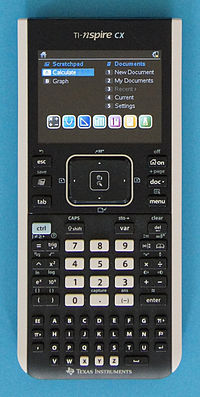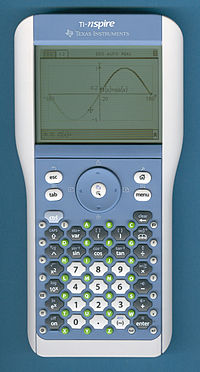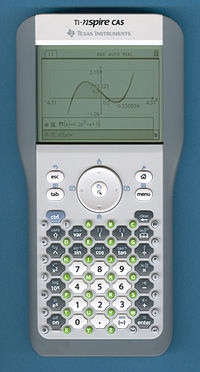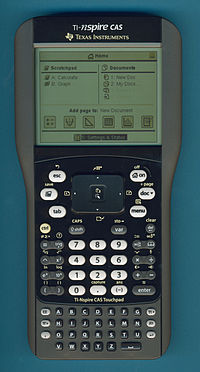- TI-Nspire series
-
TI-Nspire CX 
Type Programmable, Graphing Manufacturer Texas Instruments Introduced February 25, 2011 Predecessor TI-Nspire with Touchpad Calculator Entry mode D.A.L. Precision 14 Display Type Color LCD Display Size 320x240 (3.2 " diagonal) Programming Programming language(s) TI-Nspire BASIC, Lua User Memory 100 MB Memory Register 64 MB Other Weight 8.5 ounces, 242 grams Dimensions 7.5" x 3.4" x 0.60" TI-Nspire CX CAS 
Type Programmable, Graphing, Symbolic Manufacturer Texas Instruments Introduced February 25, 2011 Predecessor TI-Nspire CAS with Touchpad Calculator Entry mode D.A.L. Precision 14 Display Type Color LCD Display Size 320x240 (3.2 " diagonal) Programming Programming language(s) TI-Nspire BASIC, Lua User Memory 100 MB Memory Register 64 MB Other Weight 8.5 ounces, 242 grams Dimensions 7.5" x 3.4" x 0.60" TI-Nspire with Touchpad Type Programmable, Graphing Manufacturer Texas Instruments Introduced 2010 Predecessor TI-Nspire with Clickpad Successor TI-Nspire CX Calculator Entry mode D.A.L. Precision 14 Display Type LCD Dot-matrix Display Size 320x240 Programming Programming language(s) TI-Nspire BASIC, Lua User Memory 20 MB Memory Register 16 MB Other Weight 9.9 ounces, 280 grams Dimensions 7.8" x 3.9" x 0.85" TI-Nspire CAS with Touchpad Type Programmable, Graphing, Symbolic Manufacturer Texas Instruments Introduced 2010 Predecessor TI-Nspire CAS with Clickpad Successor TI-Nspire CX CAS Calculator Entry mode D.A.L. Precision 14 Display Type LCD Dot-matrix Display Size 320x240 Programming Programming language(s) TI-Nspire BASIC, Lua User Memory 20 MB Memory Register 16 MB Other Weight 9.9 ounces, 280 grams Dimensions 7.8" x 3.9" x 0.85" TI-Nspire with Clickpad 
Type Programmable, Graphing Manufacturer Texas Instruments Introduced 2007 Discontinued 2010 Predecessor TI-84 Plus
TI-84 Plus Silver EditionCalculator Entry mode D.A.L. Precision 14 Display Type LCD Dot-matrix Display Size 320x240 Programming Programming language(s) TI-Nspire BASIC, Lua User Memory 20 MB Memory Register 16 MB Other Weight 8.9 ounces, 252 grams Dimensions 7.9" x 3.9" x 0.85" TI-Nspire CAS with Clickpad 
Type Programmable, Graphing, Symbolic Manufacturer Texas Instruments Introduced 2007 Discontinued 2010 Predecessor TI-89 Titanium
Voyage 200Successor TI-Nspire CAS with Touchpad Calculator Entry mode D.A.L. Precision 14 Display Type LCD Dot-matrix Display Size 320x240 Programming Programming language(s) TI-Nspire BASIC, Lua User Memory 20 MB Memory Register 16 MB Other Weight 8.9 ounces, 252 grams Dimensions 7.9" x 3.9" x 0.85" The TI-Nspire product line is a series of graphing calculators developed by Texas Instruments. This line currently includes the TI-Nspire, TI-Nspire CAS, TI-Nspire CX and TI-Nspire CX CAS. There is also software available for Windows and Mac OS X that act in simlar ways to the calculators and allow the user to create compatible files. In 2010, Texas Instruments updated the calculators to the Touchpad versions which come with the Nspire or Nspire CAS computer software and support optional rechargeable batteries. In 2011, TI announced two new models of the TI-Nspire series: Nspire CX and Nspire CX CAS. The main new features are the color screen, rechargeable battery and thinner design.
Contents
Handhelds
The TI-Nspire series is completely different from the previous versions of the Texas Instruments's calculators. Because TI wanted the calculator to feel more familiar for new users, the TI-Nspire uses a user interface that is more similar to PCs than regular calculators. It also handles documents in a similar way to PCs. The TI-Nspire was the first to be released in two models; a numeric and CAS version. The numeric is slightly similar in features to the TI-84, except with a bigger and higher resolution screen and a full keyboard. The higher resolution screen makes it possible to draw graphs that are more detailed. The feature that the numeric lacks is the ability to solve algebraic equations such as indefinite integrals and derivatives. To fill in the gap of needing an algebraic calculator, Texas Instruments introduced the second model with the name TI-Nspire CAS, where CAS stands for Computer Algebra System. The CAS is designed for college and university students, giving them the feature of calculating many algebraic equations like the Voyage 200 and TI-89, in other words it's a replacement to those models. However, the Nspire does lack part of the ability of programing and installing additional apps that the previous models had, although a limited version of TI-BASIC is supported, along with Lua in later versions.
Both the Nspire and Nspire CAS calculators have 16 MB of NAND Flash, 20 MB of SDRAM, and 512 KB of NOR Flash. The NAND Flash contains the operating system and saved documents and is not executable. The SDRAM likely contains an uncompressed version of the OS, and a copy of all active documents. The NOR Flash contains boot instructions for loading the operating system.
The Nspire family does not contain a backup battery (like all previous models) so when a battery is removed, the SDRAM content is deleted, hence the need to load the operating system and file structure from the NAND Flash to the SDRAM, causing a longer loading time.
TI-Nspire
The standard TI-Nspire calculator is comparable to the TI-84 Plus in features and functionality. It features a TI-84 mode by way of a replaceable snap-in keypad (included) and contains a TI-84 Plus emulator. The likely target of this is secondary schools that make use of the TI-84 Plus currently or have textbooks that cover the TI-83 (Plus) and TI-84 Plus lines, and to allow them to transition to the TI-Nspire line more easily.
Because the TI-Nspire lacks a QWERTY keyboard, it is acceptable for use on the PSAT, SAT, SAT II, ACT, AP, and IB Exams.
TI-Nspire CAS
The TI-Nspire CAS calculator is capable of displaying and evaluating values symbolically, not just as floating-point numbers. It includes algebraic functions such as a symbolic differential equation solver: deSolve(...), the complex eigenvectors of a matrix: eigVc(...), as well as calculus based functions, including limits, derivatives, and integrals. For this reason, the TI-Nspire CAS is more comparable to the TI-89 Titanium and Voyage 200 than to other calculators. Its likely targets are college students and universities. Unlike the TI-Nspire, it is not compatible with the snap-in TI-84 Plus keypad. It is accepted in the SAT and AP exams but not in the ACT[1] or IB.
TI-Nspire Touchpad
On March 8, 2010, Texas Instruments announced the new TI-Nspire Touchpad and TI-Nspire CAS Touchpad graphing calculators. In the United States the new calculator was listed on the TI website as a complement to the TI-Nspire with Clickpad while in some other countries, the calculator was introduced as a successor to the previous model. The calculators were released alongside the OS 2.0 update, which featured a number of updates to the user interface and new functions.
The keyboards on the touchpad keypads featured a different and less crowded key layout along with the touchpad, which is used for navigation. The touchpad keypads are also compatible with older calculators that are running OS 2.0 or newer. The new calculators that were shipped with touchpad keypads supported an optional rechargeable battery. The second generation is also available in two models, the TI-Nspire Touchpad and TI-Nspire CAS Touchpad, and each model has maintained the color of itself, with the normal one being white and light blue while the CAS is black and gray.
TI-Nspire Touchpad EZ-Spot
To reduce theft of school-owned TI-Nspire calculators, Texas Instruments also introduced the EZ-Spot Teacher Packs with a bright, easy-to-spot, "school bus yellow" frame and slide case. The hardware of both versions are the same, with the only differences being cosmetic. The TI-Nspire calculators that were released after the touchpad Nspires also have EZ-Spot versions.
TI-Nspire CX and TI-Nspire CX CAS
The new TI-Nspire CX and CX CAS are the latest update to the TI-Nspire series. They have a thinner design with a thickness of 1.57 cm (almost half of the TI-89), a 1060mA rechargeable battery (wall adapter is included in the retail package), and a 320 by 240 pixel full color backlit display (3.2" diagonal), and OS 3.0 which includes features such as 3D graphing.[2]
Texas Instruments currently lists the TI-Nspire CX at $150 and the CX CAS at about $165. The CX series were also released to compete with the Casio Prizm[3] which is priced at $120 and has similar features.
The TI-Nspire CX series differ from all previous TI graphing calculator models in that the CX series are the first to implement a rechargeable 1060 mA Lithium-Ion battery (previous models required AAA batteries). TI includes an AC adapter for charging the battery; however, the device can also be charged via a PC USB connection. TI claims that the battery requires four hours to charge, and a full charge powers the device for up to two weeks under normal daily use. The battery is user-replaceable and can be purchased via the TI education website for $15 in the United States.
With the exception of interchangeable TI-84 keypads, the CX series retain all features of the previous TI-Nspire models. The colors of the calculator are still the same as those of the TI-Nspire models; the CX is white and dark blue, while the CX CAS is gray and black. The external connectors have changed slightly. The mini-USB port, located at the center of the top of the TI-Nspire series, has moved to the right on the CX series. On the CX series, TI added a second port immediately left of the mini-USB port, for a new wireless module. The new wireless TI-Nspire Navigator adapter, which allows teachers to monitor students and send files, is not compatible with the previous TI-Nspire models. The third port, located at the bottom of the handheld, is for the TI Charging Dock and Lab Cradle. The keypad layout is very similar to that of the TI-Nspire Touchpad.
Both models have 100MB of user memory and 64 MB of RAM. The retail package does not include the full user's guide, although the teacher edition does. Both devices ship with the student/teacher software for Windows/Mac OS X. According to Texas Instruments, The CX is accepted in SAT, IB, AP and ACT and the CX CAS only on SAT and AP.
TI-Nspire Software
The TI-Nspire desktop application is the companion to the TI-Nspire handhelds, allowing the user to create, edit, and save documents in the same manner as on the TI-Nspire. The TI-Nspire PC desktop application software emulates of all the features of TI-Nspire handheld; however, desktop application execution is usually (depending on the architecture of the PC) considerably faster than the TI-Nspire handheld. The aforementioned performance difference is mostly due to hardware architecture and desktop application/device firmware compilation differences. The user may create and modify documents on either the TI device or desktop application, and the user may also seamlessly exchange files between the device and the desktop application. The TI Nspire desktop application currently consists of four versions: TI-Nspire Student software and the TI-Nspire Teacher software, each having a numeric and CAS version.
OS versions
- 1.0.491 (June 2006) - Prototypes
- 1.0.526 (September 2006) - Prototypes
- 1.1.8916 (Late 2006 / Early 2007) - Prototypes
- 1.1.9170 (May 7, 2007)
- 1.2.2394 (August 30, 2007)
- 1.3.2437 (January 8, 2008)
- 1.4.11643 (July 9, 2008)
- 1.6.4295 (October 29, 2008, released December 9, 2008)
- 1.7.2741 (May 19, 2009, released June 6, 2009)
- 1.8 (build 80) Dev (Late 2009) - Prototypes
- 2.0.0.1188 (March 5, 2010)
- 2.0.1.60 (May 3, 2010)
- 2.1.0.631 (July 17, 2010)
- 3.0.1.1753 (April 2011)
- 3.0.2.1791 (May 2011)
- 3.1.0.392 (September 7, 2011)
The current TI-Nspire calculators are now running the OS version 3.1.0.392, released Sept. 7th, 2011. The operating system has been updated frequently since 2007 (partly due to bugs and missing functions), one year after its release in 2006. Version 2.0 and 3.0 were major upgrades that added many features.
Added features in OS 2.0
- Scratchpad (Easily and quickly use a calculator and graph)
- New, more organized home screen
- Calculator application changes
- Solving of systems of equations (linear or non-linear)
- Complex and real roots of polynomials
- Derivative at a point
- Remainder, quotient, coefficients, and degree of polynomials
- Greatest common divisor
- Central difference quotient with steps
- Creation of a zero matrix
- New programming capabilities
- Ability to separate a programming page from a calculator page
- Request and RequestStr I/O functions
- Output text
- Graphs application changes
- Can toggle table of values
- Can hide object selection guides
- Custom sequence graphs
- Zoom to decimal
- Analyze Graph menu
- Zero
- Minimum
- Maximum
- Intersection
- Inflection
- dy/dx
- Integral
- New geometry application is simply a graphing application that can only make shapes
- Data and Statistics application changes
- Ability to add X and Y variables with frequency
- Notes application changes
- Calculations in the Notes application,
- New graph settings page
Added features in OS 3.0
Images can be included in TI-Nspire documents using the computer software. They can then be displayed on the Nspire calculators and in full color on the Nspire CX calculators. Graphs can be drawn on top of the images. A data collection application is included with the OS, for use with the Lab Cradle. 3D graphing is supported, as well as differential equations. Other features were also added, including improvements to functions that are related to statistics.[4] OS 3.0 also adds the ability to run programs that are written in Lua.[5][6] OS 3.0.1 introduced a number of bugs,[7] but most of these have been fixed as of 3.0.2.[8]
Other features
One feature includes a periodic table, useful for chemistry classes. As with some other TI graphing calculators, the TI-Nspire can be used with sensors to deal with the real world (data acquisition) such as Vernier EasyTemp, Vernier Go! Motion, Vernier Go! Temp, or Texas Instruments CBR2 motion detector.[9][10][11] In addition, it has been hacked to run homebrew software.[12] With the release of OS 3.0, the Lua Scripting Language is supported, allowing 3rd party programs to be run without the need of exploits.[5][6]
Lab Cradle
The TI-Nspire Lab Cradle continues the idea of the original Calculator-Based Laboratory System (CBL™) introduced already in 1994, a portable and versatile data collection device for math and science. The CBL system was replaced in 1999 with its successor CBL 2, featuring three analog inputs and an ultrasonic motion detector input to connect the Calculator-Based Ranger, CBR and its successor CBR 2. The TI-Nspire Lab Cradle sports three analog inputs with a sampling rate of up to 100,000 samples per second and two digital sensor ports. The integrated 32 megabytes of storage space allows for handling large amounts of data.
The TI-Nspire Lab Cradle is powered by the TI-Nspire rechargeable battery and support three different charging options: wall adapter, USB cable to computer and TI-Nspire Cradle Charging Bay. The TI-Nspire Lab Cradle being marketed by Texas Instruments was developed as part of an ongoing business alliance between TI and Vernier Software of Portland, Oregon.
The Navigator system allows teachers to connect a network of TI-Nspire calculators to a computer through the TI-Nspire Access Point and TI-Nspire Navigator Wireless Cradles. The system includes the TI-Nspire Cradle Charging Bay and the main system which looks like a wireless router. The Navigator system was first available when the first generation Nspires were launched, but when the TI-Nspire CX and CX CAS were released, a new wireless adapter was announced that is smaller but not compatible with the TI-Nspire and TI-Nspire Touchpad.
Press-to-Test
Press-to-Test is a feature that restricts access to the user's documents and certain features of the calculator for a limited time. Its intended purpose is to prevent cheating on tests and exams. Press-to-Test is enabled by pressing a certain button combination when turning on the calculator. The features that are blocked (for example 3D graphs and drag & drop for graphs) can be selectively enabled, but access to existing documents is always prohibited. When the handheld is running in Press-to-Test mode, a LED on top of it blinks to indicate that Press-to-Test hasn't been disabled. Press-to-Test can only be disabled by connecting to another calculator or a computer with TI-Nspire compatible software installed. Removing the batteries will not disable it.
Voyage 200 vs. TI-Nspire CAS
When comparing the TI-Nspire CAS to the Voyage 200 or TI-89, there are many advantages:
- TI-Nspire is fully compatible with computers running Windows or Mac OS X by USB cable, while the Voyage is less so.
- Larger and higher resolution screen, color LCD in the CX models, compared to the Voyage, making graphs more detailed, especially in 3D.
- The Nspire commands are similar to the ones commonly used with computers, for example: To copy, press Ctrl+C, like in a computer. This simplifies the learning curve for some users.
- Students create and save all of their work as documents with notes, thus enabling teachers to see problem-solving techniques and assess individual student understanding. These documents can be sent to computers, other handhelds and printers.
- Symbolic mathematics templates on the input as well as output, or "PrettyPrint" - the ability to show the results as they would normally be written. The Voyage 200 and TI-89 did this to output, while input remained standard.
- More powerful compared to the Voyage 200. The Nspire can handle bigger matrices, a broader selection of equations and functions, all more quickly, since the processor is more powerful.
- Space - the new CX models have up to 100 MB of user memory, while the Nspire had about 20 MB of user memory.
- Graphing has been updated, giving users the option to derive or integrate a function in-graph.
- Spreadsheet function which is similar to a list editor. Data from spreadsheets and lists can be analyzed and graphed.
- Data and statistics functions have been improved.
- It is possible to view several pages of data at once, effectively splitting the screen between each page. The user can interact with any portion at a time.
- The Nspire is capable of opening files that support images.
- The Nspire has a new Vernier DataQuest function which can be used to collect data from any sensors connected to the Lab Cradle, which allows up to 5 sensors, or one sensor probe can be connected via USB port on top of the handheld.
However there are many things that the TI-Nspire lacks from the Voyage 200 and TI-89:
- The V200 and TI-89 can solve many algebraic equations, and data input on the TI-89 can be easier for the user than the Nspire.
- The V200 was capable of 3D graphing first. For the Nspire, this function was introduced in an OS update.
- The TI-89 and V200 have better programing capabilities. The Nspire is less capable of a programming platform.
- Apps (like ME*Pro) and the Symbolic Math Guide (SMG) are not available on the TI-Nspire.
- The Voyage features a full QWERTY keyboard, which makes programming and other text input easier for the user. However, some tests do not allow calculators with a QWERTY keyboard.[1][13]
See also
References
- ^ a b "ACT FAQ : Can I use a calculator?". Actstudent.org. http://www.actstudent.org/faq/answers/calculator.html. Retrieved 2010-08-31.
- ^ "Texas Instruments specifications page". http://education.ti.com/educationportal/sites/US/productDetail/us_nspire_cx_cas.html?bid=5. Retrieved 2011-02-28.
- ^ Casio Education: PRIZM - Graphing Calculator
- ^ "TI-Nspire™ Technology Version 3.0 Release Notes" (PDF). Texas Instruments. April 2011. http://education.ti.com/sites/US/downloads/pdf/TI-Nspire%203%200%20Release%20Notes_EN.pdf. Retrieved 2011-08-01.
- ^ a b "Lua Programming Environment on the TI-Nspire Found". ticalc.org. http://www.ticalc.org/archives/news/articles/14/147/147339.html. Retrieved 2011-07-18.
- ^ a b "TI-Nspire™ Technology - Lua Scripting". Texas Instruments. http://education.ti.com/nspire/scripting. Retrieved 2011-08-21.
- ^ "Beware Installing TI-Nspire OS v.3". ticalc.org. http://www.ticalc.org/archives/news/articles/14/147/147367.html. Retrieved 2011-08-21.
- ^ "TI-Nspire OS 3.0.2 Released". ticalc.org. http://www.ticalc.org/archives/news/articles/14/147/147447.html. Retrieved 2011-08-21.
- ^ Vernier Software & Technology Global Gateway
- ^ CBR 2 by Texas Instruments -US and Canada
- ^ Data Collection - TI-Nspire.com by Texas Instruments
- ^ "Nspire Models Opened to Third-Party Development". ticalc.org. http://www.ticalc.org/archives/news/articles/14/145/145908.html. Retrieved 2010-08-31.
- ^ "SAT Test Day Checklist - Bring Your Admission Ticket, Calculator, and more". College Board. http://sat.collegeboard.org/register/sat-test-day-checklist#calcPolicy. Retrieved 12-09-2011.
External links
- TI-Nspire series official site
- Texas Instruments Calculators & Education Technology
- Datamath Calculator Museum
- LUA programming on the TI-Nspire
- TI-Nspire series hacks
- TI-Nspire series Training Videos
- TI-Nspire series Google Discussion Forum
- TI-Nspire series user programs
- TI-Nspire series BASIC
- TI-Nspire series program collection
Texas Instruments calculators Z80-based graphing: m68k-based graphing: ARM-based graphing: Other graphing: Non-graphing programmable: Scientific models: Financial models: Other models: Related: Categories:- Graphing calculators
- Texas Instruments calculators
- Computer algebra systems
Wikimedia Foundation. 2010.


